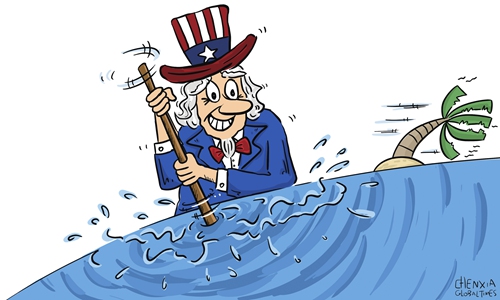US-China emergency channels for S.China Sea needed now
By Shi Xiaoqin Source: Global Times Published: 2020/7/19 13:53:40

Illustration: Chen Xia/GT
On July 13, one day and four years after the ill-founded Arbitral Tribunal's South China Sea ruling, US Secretary of State Mike Pompeo said in a statement the tribunal's decision is "final and legally binding." Pompeo also said that most of China's maritime claims in the South China Sea are "completely unlawful." The US is making waves in the South China Sea, adding anxieties to relevant countries suffering from the coronavirus pandemic.
What actions will the US possibly take to support its new position? There is a chance that military options might be undertaken.
The US feels uncomfortable about China's construction of islands and reefs in the South China Sea, as well as corresponding military deployments there in recent years. From Western perspectives, the value of the South China Sea in the new major power competition is as strategic as the importance of the Malta Channel or the Strait of Gibraltar to the global oceans. Therefore, the US has ratcheted up its so-called freedom of navigation operations in the South China Sea.
With the intensifying of China-US competition, the South China Sea has become one of the key areas that the US is strengthening its containment and pressure on China. In fact, the United States Strategic Approach to the People's Republic of China issued by the White House in May said that "the United States will increase public pressure on the PRC government and take action to protect United States interests by leveraging proportional costs when necessary." It claims that the US will continue freedom of navigation operations in the South China Sea to push back on "China's hegemonic assertions and excessive claims."
Pompeo's July 13 statement, combined with recent US moves in the region, leads to speculation that in the future the US is likely to adopt more diverse and intense military operations in the South China Sea. China and the US are in a perilous stage. The two are constantly testing each other's bottom line. This is full of uncertainties and dangers. During the early stages of the original Cold War in the 1950s, there were continuous crises between the US and the Soviet Union. The two countries didn't start to reexamine their own strategies until the Cuban Missile Crisis brought them to the brink of nuclear war in 1962.
In the South China Sea, the US may have three ways to strategically test China. First, the US can conduct so-called freedom of navigation operations. Second, the US may send military forces to interfere in the disputes between China and its neighboring countries. Third, the US may create crises to try to sound out China's bottom line and show off its own strength and will. In recent years, TV reporters may be on the scene as warships and aircrafts provoke China in the South China Sea. This is a clear example of a deliberate provocation.
We need to evaluate whether the current crisis management mechanisms can work to deal with possible crises. In 2001, a US aircraft collided with a Chinese fighter over the South China Sea, exposing the flaws in the two sides' crisis management and control. Thereafter, China and the US established the Beijing-Washington hotline between the two defense authorities in 2007. The two sides also signed Memorandum of Understanding on Notification of Major Military Activities and Confidence-Building Measures Mechanism and the Memorandum of Understanding Regarding the Rules of Behavior for Safety of Air and Maritime Encounters in 2014. These have played a positive role in maintaining China-US strategic stability.
But the two MOUs focus on crisis prevention and accident management in peace time. It is still unknown how the two sides will carry out crisis management when real major military crises occur. We should not passively deal with a horrible situation after it happens. We should focus on preventing it. First, we need to set up hypothetical scenarios and test the existing crisis management mechanisms. Second, we need to establish effective crisis communication mechanisms with US, including how we can jointly define and defuse possible crises, agree on how to communicate when a certain crisis occurs, and create specific accords for special channels to cool down any situation or unexpected emergency event.
To maintain peace and stability in the South China Sea, we should maintain strategic focus, urge the US to exercise restraint, warn the international community of possible consequences if the US acts rashly, test existing crisis management mechanisms, and try to conduct consultations with the US to prevent possible crises.
The author is a research fellow with the National Institute for South China Sea Studies and the School of Public Affairs at Zhejiang University. opinion@globaltimes.com.cn
Posted in: VIEWPOINT